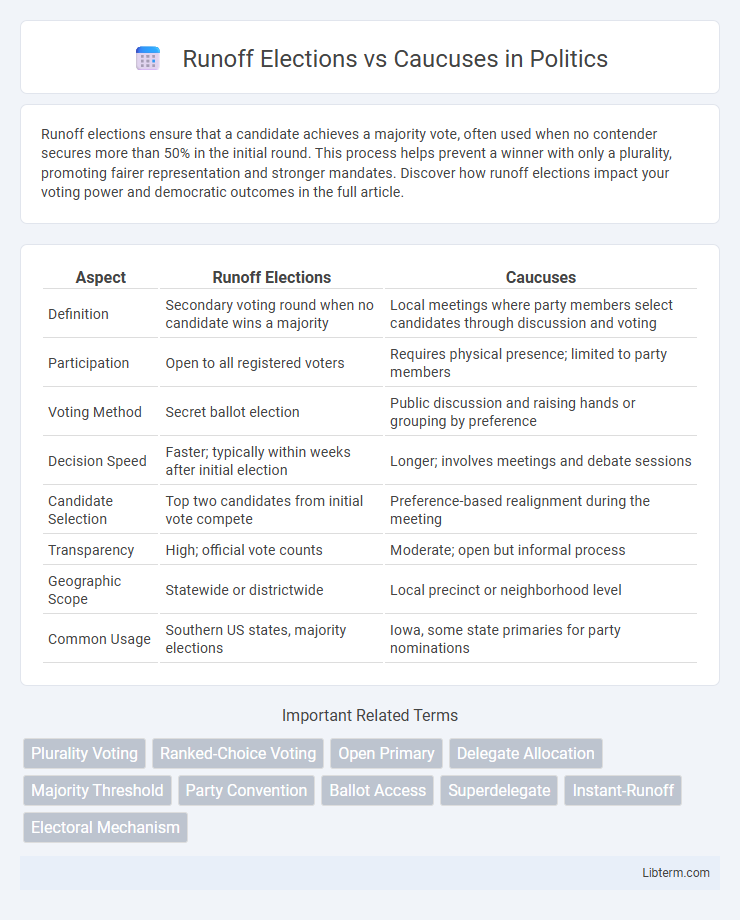Runoff elections ensure that a candidate achieves a majority vote, often used when no contender secures more than 50% in the initial round. This process helps prevent a winner with only a plurality, promoting fairer representation and stronger mandates. Discover how runoff elections impact your voting power and democratic outcomes in the full article.
Table of Comparison
| Aspect | Runoff Elections | Caucuses |
|---|---|---|
| Definition | Secondary voting round when no candidate wins a majority | Local meetings where party members select candidates through discussion and voting |
| Participation | Open to all registered voters | Requires physical presence; limited to party members |
| Voting Method | Secret ballot election | Public discussion and raising hands or grouping by preference |
| Decision Speed | Faster; typically within weeks after initial election | Longer; involves meetings and debate sessions |
| Candidate Selection | Top two candidates from initial vote compete | Preference-based realignment during the meeting |
| Transparency | High; official vote counts | Moderate; open but informal process |
| Geographic Scope | Statewide or districtwide | Local precinct or neighborhood level |
| Common Usage | Southern US states, majority elections | Iowa, some state primaries for party nominations |
Understanding Runoff Elections: A Quick Overview
Runoff elections occur when no candidate achieves the required majority in the initial voting round, triggering a second round between the top contenders to ensure a decisive winner. This system is common in states like Georgia and Louisiana, where it aims to enhance majority support and legitimacy for the elected official. Runoff elections contrast with caucuses, which are party-organized meetings focusing on candidate selection through discussion and consensus rather than direct voting.
What Are Caucuses? Key Principles Explained
Caucuses are local gatherings where registered party members openly discuss and vote for their preferred candidates, emphasizing active participation and community engagement. Unlike primary elections, caucuses focus on consensus-building through deliberation and real-time interaction rather than secret ballots. This system fosters grassroots involvement and allows candidates to gauge public support directly within the party's framework.
How Runoff Elections Work: Step-by-Step
Runoff elections activate when no candidate achieves the required majority, typically over 50%, in the initial vote, prompting the top two candidates to compete in a subsequent round. Voters return to the polls to choose between these finalists, ensuring the winner secures a majority consensus. This system enhances electoral legitimacy by preventing winners from claiming victory with mere plurality votes in crowded races.
The Structure of Caucus Systems: From Start to Finish
Caucus systems begin with local gatherings where registered party members discuss and vote on candidates through a series of rounds, often leading to realignment as supporters of lower-ranked candidates choose new preferences. Each caucus session culminates in delegates being elected to represent the winning candidates at higher-level conventions, ultimately determining party nominees. This multi-tiered, interactive process contrasts with runoff elections, which involve a straightforward, statewide voting process between the top candidates from an initial election.
Voter Participation: Runoff Elections vs Caucuses
Runoff elections typically see higher voter participation than caucuses due to their straightforward voting process and extended polling hours, allowing more voters to cast ballots conveniently. Caucuses often require a greater time commitment and active participation in discussions, which can limit attendance to highly motivated or engaged individuals. Consequently, runoff elections tend to be more representative of the general electorate, while caucuses may reflect the preferences of more dedicated party activists.
Pros and Cons of Runoff Elections
Runoff elections enhance democratic legitimacy by ensuring the winning candidate secures a majority, reducing the chances of a candidate winning with only a plurality. However, they can lead to voter fatigue and lower turnout due to the need for multiple voting rounds. Runoff elections also increase administrative costs and prolong the election process, potentially delaying the transition of power.
Advantages and Disadvantages of Caucuses
Caucuses offer advantages such as promoting in-depth discussion among voters and encouraging active community engagement, leading to more informed candidate selections. However, disadvantages include lower voter turnout due to the time-consuming and complex process, which can disproportionately exclude those with scheduling conflicts or disabilities. The public and participatory nature of caucuses may also result in social pressure influencing voter choices, potentially compromising ballot secrecy.
Impact on Election Outcomes: Runoff vs Caucus
Runoff elections often result in higher voter turnout compared to caucuses, as they provide a more straightforward voting process and allow broader participation beyond dedicated party activists. Caucuses tend to favor candidates with strong grassroots support and higher engagement among party loyalists, potentially leading to outcomes less representative of the general electorate. The impact on election outcomes reveals that runoffs can moderate candidate selection by appealing to a wider voter base, while caucuses may produce more ideologically driven results.
State Examples: Where Runoff Elections and Caucuses Are Used
Runoff elections are commonly used in states like Georgia and Louisiana to ensure a candidate receives a majority vote in primary elections, particularly when no candidate surpasses the 50% threshold initially. Caucuses are primarily associated with states such as Iowa and Nevada, where party members gather in local meetings to select presidential delegates through discussion and voting. These distinct methods reflect varied approaches to candidate selection, emphasizing either broad voter participation in runoffs or party-centered deliberation in caucuses.
Future Trends: The Evolving Role of Runoff Elections and Caucuses
Runoff elections are increasingly favored for ensuring majority voter support in tightly contested races, especially in states aiming to enhance electoral legitimacy and reduce vote fragmentation. Caucuses, traditionally grassroots and community-driven, face declining participation but are evolving with digital tools to maintain engagement and accessibility. Future trends indicate a growing preference for runoff elections in primary processes, while caucuses adapt by integrating hybrid models to balance inclusivity and voter turnout.
Runoff Elections Infographic

 libterm.com
libterm.com